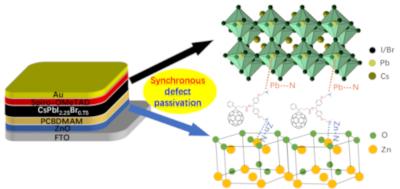Researchers from the University of Science and Technology of China and Dongguan University of Technology have found a way to improve perovskite solar cells by adding a layer that improves stability and efficiency at capturing power from sunlight.
All-inorganic perovskite solar cells are more stable at high temperatures, which is important for their long-term performance. However, they are not as efficient at converting sunlight into electricity compared to solar cells made with a mix of organic and inorganic materials. The team explored the use of an additional layer to fix the issues found in all-inorganic perovskite solar cells. In these solar cells, the layers of the perovskite material tend to encounter problems with their structure, energy levels, and electron traps. These issues reduce the movement of electrons and overall efficiency of the solar cell. To address these problems, the scientists introduced an extra layer called bis-dimethylamino-functionalized fullerene derivative (PCBDMAM) between the perovskite layer and the layer that helps with electron transport. This interlayer improves the movement of electrons and increases the solar cell's efficiency, while also enhancing its stability at different temperatures.
To make all-inorganic perovskite solar cells more efficient, researchers have been working on a technique called interface engineering. This technique involves improving the arrangement of different layers in the solar cell to make it better at moving electrons. By making adjustments to the structure and properties of the solar cell's layers, researchers have been able to improve its efficiency. Researchers have been using various types of interlayers to improve the performance of all-inorganic perovskite solar cells. These interlayers can be made of small molecules, polymers, inorganic compounds, 2D perovskite layers, fullerene, and its derivatives. They help in addressing defects in the all-inorganic perovskite layer.
In their study, the team specifically used an interlayer called PCBDMAM between an all-inorganic perovskite layer and a zinc oxide electron transport layer. The PCBDMAM was applied as a conductive coating on the zinc oxide surface using a spin-coating technique. This helped to improve the structure and quality of the all-inorganic perovskite layer, as well as enhance the thermal stability of both the zinc oxide and perovskite layers. As a result, the power conversion efficiency (PCE) of the solar cell increased from 15.44% to 17.04%.
One of the main obstacles that scientists are trying to overcome is direct recombination, which hampers the efficiency of solar cells. Direct recombination occurs when electrons, generated by sunlight in the solar cell, collide with holes (absence of electrons) and recombine. This recombination process emits a photon of light, which essentially reverses the electricity generation within the solar cell. In simpler terms, direct recombination reduces the amount of electricity that can be produced by the solar cell.
The research team aims to focus on finding ways to address solar cell defects like direct recombination, by modifying the composition, concentration, and application of the different layers in solar cells. The goal is to optimize temperature stability and efficiency in a manner that is commercially viable and cost-efficient. By tackling these challenges, the team aims to advance the technology and make solar energy an even more reliable and affordable source of power.




